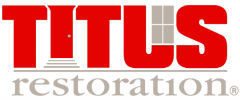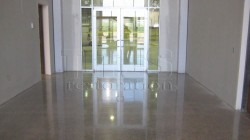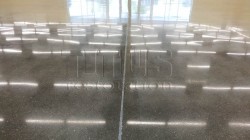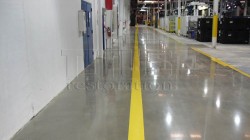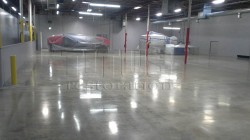The term polished concrete has grown in popularity among architects, developers, and several major retailers across the country. So what is polished concrete? Concrete polishing commonly refers to the concrete flooring treatment that has been mechanically ground and polished through a series of steps that have been determined by the desired sheen of the final floor finish. Much like sanding wood, polished concrete uses progressive coarseness of tools to refine concrete.
Commercially, we see that diamond polishing is one of the most desirable concrete floor finishes for many today. With its green benefits, long life cycle, easy cleanup, and cost effectiveness it is the preferred industrial flooring alternate to vinyl tile (VCT) for many retail stores, warehouses, schools, and offices. Many of today’s top architects are specifying Polishing Concrete as the concrete design for new construction or for concrete restoration construction projects.
- Polished Concrete Entrance
- Concrete Polishing Increases Reflection
Is Polished Concrete Suitable for Your Business?
Before making a standard list, we can say with pride that over the years we have gained experience in any sector where a concrete slab exists: residential, commercial and industrial. After studying cases in residential areas, we took a decisive step to devote ourselves exclusively to commercial and industrial floors, in order to be able to use our resources to study new cases and propose new solutions.
- Industrial Traffic Lanes
- Warehouse and Factory Floors
Polished concrete is suitable for:
- Warehouses (distribution centers, shipping and receiving)
- Factories (power plants and manufacturing plants)
- Institutional Flooring (schools and universities, hospitals, museums, churches, nursing homes, jails and prisons, fire stations, stadiums, municipalities). Read our blog here on how schools are choosing polished concrete as an alternative to VCT.
- Military Buildings (aircraft hangar, military commissary)
- Manufacturing (automobile, food and beverage, pharmaceutical)
- Retail (drugstore, dollar store, beer and wine store, beverage, hardware store, auto parts store, big box store, grocery stores)
Polishing Concrete Schedule/Sequence Suggestions
It is always our policy to wet grind and wet polish. These are the EPA preferred methods for eliminating silica dust in the air and contamination of the building. We have a strict policy concerning creating respirable silica dust as it creates the incurable occupational disease silicosis. Respirable silica cannot be seen and it is these tiny invisible particles that enter the mucus membrane of the lungs causing silicosis.
Adequate lighting is required for good polishing. Minute scratch marks from each level of diamond must be removed at each grit and the floor vacuum cleaned. It is preferable to have permanent lighting in place for all grinding and polishing:
- On larger projects, depending on the number of interior rooms to be polished, We may prefer to perform the initial deep grinds prior to interior partitions being built and returning to finish the project just prior to finish painting.
- We can provide floor protection upon request, but cannot maintain that protection during the course of the project.
- Final polishing steps should be performed after drywall and all prime painting, but prior to finish paint.
- On larger projects, it may be best to perform a final burnishing just prior just final cleaning and building turn-over (burnishing pops a shine but can cause dust).
- On larger commercial or industrial projects, wet curing and pouring the floor after the building shell is enclosed and all the overhead work is complete prevents damage to the floor. Once this work is complete, schedule to construct the interior partitions last.
Other Relevant Topics:
- Benefits of Polished Concrete
- How to Polish Concrete
- Polished Concrete Maintenance
- Expectations and Possibilities of Polished Concrete
- Tips for the GC
- Polished Concrete Cost
